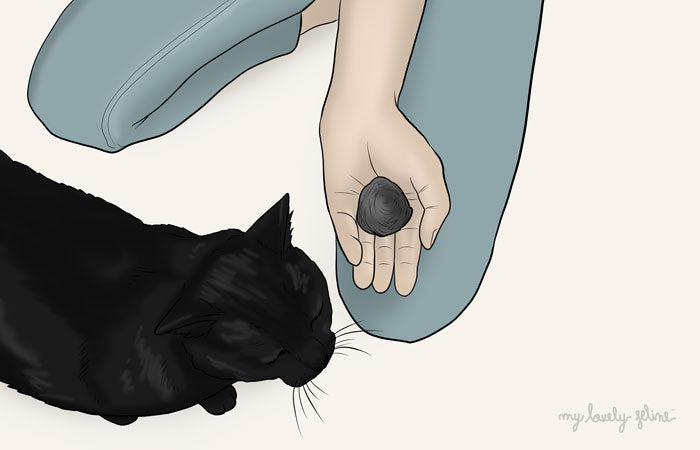—Feline Behavior Specialist 🇺🇸
|
I’ll never forget the first time I found a hairball on the floor. I freaked out, thinking it was a litter box accident until I picked it up with a tissue and realized it was a solid tube of fur! What causes these mysterious-looking fur logs? Are they normal? When should you be concerned? It’s time to take a look at hairballs and how they are a reflection of your cat’s health. |
What Are Hairballs?
Cats are fantastic groomers, thanks to tiny curved, hollow spines made of keratin on their tongues called papillae. These little spines are perfect for working out knots and dislodging dirt from a cat’s fur.
They also deposit saliva all over the body and work it down to the skin to help control body temperature. While cats are licking themselves, the papillae on their tongue will grab loose fur, which is then swallowed. Most fur is then passed through the GI tract, unprocessed, and eliminated in a cat’s stool (yes, seeing fur in your cat’s poop is healthy AND normal).
However, sometimes, the fur clumps together in the stomach, forming a wad that is too big to pass through to the intestines. Eventually, this wad is vomited up, and by passing through the esophagus, it transforms into a log shape. That is a hairball, also known as trichobezoar.
Normal or Problematic
A cat having a hairball every now and then is usually normal and not cause for concern. The frequency is up for debate, so talk with your vet about what they think is normal for your cat. (For reference, my cats have a few hairballs a year.) Keep in mind you’re more likely to see furballs when cats are shedding their winter coats before the summer.
You can often help decrease the overall frequency of hairballs by:
- Brushing your cat at least twice a week and even wiping their coat with a damp cloth to catch more loose hair. Less fur will be ingested, helping ensure fur passes easily through the digestive tract.
- Feeding more smaller meals as opposed to a few big meals. Keeping their digestive system going will help the fur pass through more easily.
- Put your cat on a food or treats designed to help with hairball control. These diets are often high in fiber, which will help pass the fur and improve your cat’s overall gut health.
- Add a digestive aid to your cat’s food. This could include:
- Coconut, avocado, sunflower, or fish oil to help improve the coat, reduce shedding, and lubricate ingested fur to help it pass.
- Probiotic to help balance healthy gut bacteria.
- Odorless and tasteless fiber powder. Check with your vet on proper dosing.
When hairballs are a cause for concern is when your cat is frequently vomiting them up, anywhere from a few times a week to a few times a month. That can (but not always) indicate:
Motility in the digestive tract decreases, meaning food and moisture aren’t properly passing through, impacting digestion.
Plus, the amount of time pathogens and antigens are in contact with the intestinal walls increases. The result is bacteria overgrowth causing a decrease in the cat’s ability to properly absorb nutrients.
It can also lead to chronic inflammation and inflammatory bowel disease (IBD), which is diagnosed by an ultrasound and biopsy.
Treatment includes probiotics (S boulardii is a very good strain for IBD), gut restoration supplements (balances the bacteria in the gut), diet change, anti-nausea meds, appetite stimulants, B12 injections, and sometimes steroids to help with the inflammation.
When a cat’s skin is itchy, they commonly overgroom to get some sort of comfort. They will also lick their fur when they’re anxious as a coping mechanism. A good rule of thumb is to make sure you cover the easily treatable issues first.
Apply preventative flea treatment and ask your vet about dewormers. After you’ve ruled out those easy-to-fix things, you can start looking at other issues like environmental and food allergies, anxiety, and even other possible medical explanations.
The treatment for environmental allergies covers a large spectrum of different allergy medicines, supplements, and steroids. Food allergies are often managed with a prescription diet. Anxiety can be tackled through behavior modification, along with other helpful tools like acupuncture, pheromone diffusers and sprays, calming collars, and medication.
Danger Zone
While not common, large furballs that can’t pass can cause an obstruction that requires surgery or some other intervention. Symptoms of an obstruction (of any object) include:
- Gagging without anything coming up
- Change in personality
- Lethargy or decreased energy level
- Loss of appetite
- Hiding
- Constipation or diarrhea
If you see these symptoms, reach out to your vet immediately, because obstructions are life-threatening.
My Cat Keeps Coughing
When your cat repeatedly coughs but nothing comes up, yes, it can be a hairball, but it can also be a lot of other things, including pneumonia, asthma, or even post nasal drip from an upper respiratory infection.
Do not ignore this behavior. If your cat keeps coughing and nothing is coming up, call your vet. I also recommend trying to get a video of the behavior. It will be very helpful when your vet is performing an assessment to see the exact behavior.
Conclusion
A few hairballs over a long course of time is usually nothing to worry about. If you start seeing frequent hairballs, coughing, or any indication of an obstruction, call your vet. They can advise you on the best next steps based on your cat’s behavior, and help make sure they’re healthy and safe.
Sources:
Barber, Ellen. AnimalBiome, Your Cat Has Hairballs: Should You Worry?.
Coates, Jennifer. PetMD, Best Cat Food and Treats for Hairballs.
Green, Amanda. MentalFloss, 7 Facts About Hairballs.
Pet Pros Staff. Pet Pros, 3 Ways to Naturally Reduce Hairballs.
Sherck, Margie. Cat Friendly Homes, Hairballs.
Article by Elizabeth Italia 🙋♀️
Cat Behavior & Fostering Specialist



